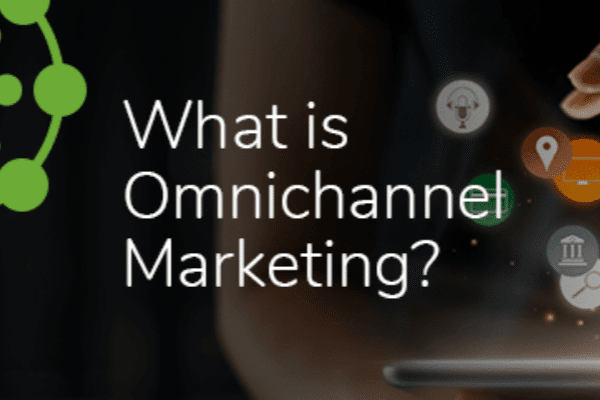Today’s customers use multiple channels — laptops, smartphones, brick-and-mortar stores and much more — to interact with brands. According to a recent report from Google, 90 percent of consumers use multiple devices to accomplish a single task online.
To effectively reach their audiences, companies need to use a cross channel marketing strategy. While using multiple channels is a smart approach, the most successful brands use a strategy called omnichannel marketing. Check out the topis this article will cover:
- What Is Omnichannel Marketing?
- Omnichannel Marketing Vs. Multichannel Marketing
- 5 Omnichannel Marketing Tips
What Is Omnichannel Marketing?
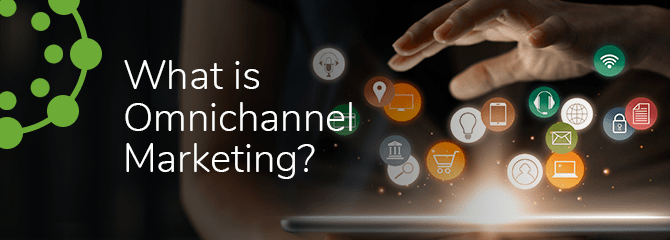
See How Lotame Can Help Your Omnichannel Marketing
What is omnichannel marketing? It’s an approach to marketing that involves using multiple channels for customer engagement in an integrated way, creating a seamless customer experience across channels.
With omnichannel marketing, whether a customer is shopping on your ecommerce site from their laptop or smartphone, viewing an ad on TV or visiting a brick-and-mortar store, they’ll have a consistent experience. All of the various channels share information, enabling you to use them optimally and create personalized experiences across them.
Omnichannel Marketing Vs. Multichannel Marketing
Omnichannel and multichannel marketing have many similarities, and omnichannel may even be considered a type of multichannel marketing. An omnichannel experience, however, takes the strategy a step further.
The prefix multi- means “many,” while omni- means “all.” To be classified as multichannel, a marketing strategy only needs to use more than one channel. To be an omnichannel strategy, all of the channels used need to be connected to create a consistent, cohesive, seamless customer experience.
See How Lotame Can Help Your Omnichannel Marketing
1. Customer-Centricity
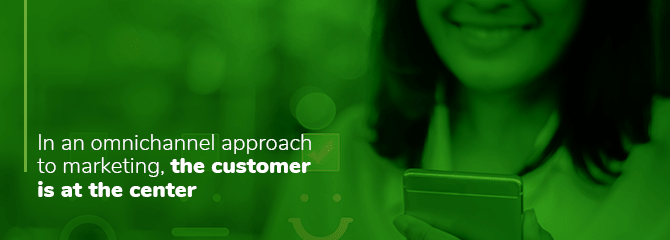
In an omnichannel approach to marketing, the customer is at the center. All of the channels are connected, receiving information from the customer and providing them with a personalized, seamless experience. For instance, if a customer buys size 9 boots in your ecommerce store, that information gets fed to your other channels. Your social media ads for the customer might recommend similar products or ones that other shoppers frequently buy with the boots the customer purchased. If that customer provides their account information to a salesperson in a brick-and-mortar store, that representative can pull up their shoe size and information about their preferences in shoe style.
In a multichannel experience, the channels are at the center. All of the channels separately feed information to the customer, but the channels aren’t connected and aren’t focused on the preferences of the customer. They simply send messages to the target audience in a non-integrated way.
2. Consistency
In a multichannel marketing approach, all of the channels function as separate entities, reducing the consistency between them. While you can work to make your various channels more consistent, doing so takes a significant amount of time and energy, and you won’t be able to keep them all updated in real time. Essentially, if the customer wanted a truly consistent experience, they’d have to choose one of your channels and exclude all of the others.
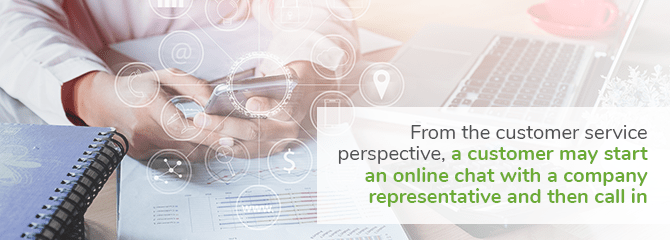
If you use the omnichannel approach, however, the experience will be consistent across all of the channels. The fact that the channels are connected enables this. You can send information between the channels, often automatically. If a customer clicks one of your banner ads for a new car, for example, you can use that information to show that customer more ads for that type of car on social media. From the customer service perspective, a customer may start an online chat with a company representative and then call in. With an omnichannel system in place, the customer service rep who answers the phone would have access to the information from the chat.
3. Reduced Friction
Another goal of omnichannel marketing is to remove friction and effort from the customer experience. In a multichannel system, the customer has to give each channel information separately, meaning they may have to do it multiple times. For example, they might like a post about a product on social media, then go search for it on your website, look it up again later on their smartphone and then, finally, go find it in the store to buy it. The customer has to put forth a lot of effort, meaning they’re less likely to make the purchase.
An omnichannel approach uses the flow of data between the various channels to reduce friction and encourage customers to make a purchase. If you have an omnichannel system and your customer likes a post about a product on social media, they’ll then see an ad about the product. If they click on the ad, it will take them to the product page on your website. If they have a customer account on your site, your system can automatically add the product to a list of items they’re interested in. Then, when they pull your site up on their phone or sign in at a kiosk at your store, they can quickly find the information they need about the product.
What Does Omnichannel Marketing Look Like?
Here are some examples of what omnichannel marketing looks like for real companies.
Crate and Barrel’s Mobile Totes program is an excellent example of an omnichannel marketing strategy. The furniture and housewares retailer partnered with software company CloudTags to create a connected physical store shopping experience. Throughout one of its stores, the company set up tablets called Mobile Totes, which customers can use to scan the barcodes on products to get information about them such as reviews, color options and inventory information. Customers can also search for items and add products to a wish list.
Customers can then have a sales associate help them gather their items and purchase them at a checkout line. If the customer doesn’t buy the items in the store, they can email their list to themselves using the tablets. Crate and Barrel can then use this information to target banner ads to the customers. According to Crate and Barrel, the program resulted in a 10 percent increase in sales at the store.
Walt Disney World is another example of a company that has had success with omnichannel marketing. They have a user-friendly website, which is optimized for all kinds of devices and is mobile-responsive. Once you book your trip to the resort, you can plan your visit using the My Disney Experience feature. Then, when you’re at the park, you can use the app to get directions to the attractions you saved and see estimated wait times for them.
The Magic Band program is another addition to Disney’s omnichannel campaign strategy that creates a more connected experience for guests. You can use the smart wristbands to enter the park, check in to FastPass lanes, charge purchases and unlock your hotel room. The bands are also connected to your My Disney Experience account and Disney PhotoPass account.
Essential Features of an Omnichannel Marketing Strategy
How do you build a successful omnichannel marketing strategy to address the entire customer journey? Here are the key components and how Lotame can help you with them.
1. Audience Segmentation
Audience segmentation is the practice of splitting your audience into groups that have similar characteristics. You might, for instance, create groups based on age range, gender, interests, job titles and a vast array of other qualities. You can also base a segment on multiple attributes.
Splitting your audience into groups like this enables you to target your marketing materials and content more precisely. You could create one ad for a group of customers who are sports fans and another ad for those more interested in music, for example. You can also reach out to different segments on different channels based on which they use most frequently.
Our Spherical platform includes tools to help you create, optimize and package audience segments to improve your campaign targeting and increase your reach. Using our technology you can build audience segments using omnichannel marketing data and then test different strategies by mixing and matching data segments.
2. Cross-Device Marketing
To run an omnichannel marketing campaign successfully, you need to be able to match consumers to the numerous devices they use. This allows you to target marketing materials across the various channels each customer uses and tell sequential brand stories.
To determine which devices belong to which customers, you need an identity graph, like Lotame’s Cartographer. This feature maps the relationships that exist between different devices using probabilistic and deterministic matching. Probabilistic matching assesses the signals coming from devices to determine if any relationships may exist, while deterministic matching uses information that directly links devices together, such as login data from a website, without storing any personally identifiable information.
Determining the relationships between devices enables you to create cross-screen audience segments and target customers across screens to create more sophisticated marketing campaigns and deliver personalized content.
3. Advanced Data Management

To run a successful marketing campaign, including an omnichannel one, you need to be able to collect data from various sources and then organize that data effectively. Lotame’s Spherical platform gives you the tools to collect event-level data, such as clicks, video views and searches, whenever customers interact with your online properties. Our tools enable you to gather more granular data, giving you access to more valuable insights. You can also upload data from your customer relationship management (CRM) system, subscriptions and other offline sources to get a comprehensive view of your customers. We make it easy to bring in second-party and third-party data to enrich your first-party data.
Additionally, we provide you with the tools to organize your data and make your audience segments available on demand-side platforms (DSPs), supply-side platforms, ad exchanges and other platforms to be used for advertising, personalization and more.
4. Effective Data Analysis
You also need to be able to analyze your data effectively to learn more about your audience, determine which channels your customers are using, and evaluate how your ad campaigns are performing. Understanding how your audience interacts with your brand will help you to choose the right channels and improve the outcomes of your marketing efforts.

With Lotame Analytics, you get valuable insights into how your audience interacts with your brand online, the customer behavior attributes associated with those interactions, and how those attributes affect the path to conversion and customer loyalty. Adding in second-party and third-party data helps you to take your insights even further, and you can also easily sync your Lotame Analytics data with other business intelligence platforms to help you get the most out of your data. With the insights you gain, you can identify high-performing audience segments, improve campaign performance, and grow your brand.
5. Marketing Automation
Marketing automation is another useful tool in omnichannel strategies. It can help save you significant amounts of time and effort, which enables you to get results faster. Automated modeling can also help you quickly create audience segments and adjust your targets as your campaign runs, and with automation tools, you can designate automatic responses to a specific customer interaction. If a customer likes a product advertisement on Facebook, for example, you can set your tools up to send an email automatically with a special offer for the product.
5 Omnichannel Marketing Tips
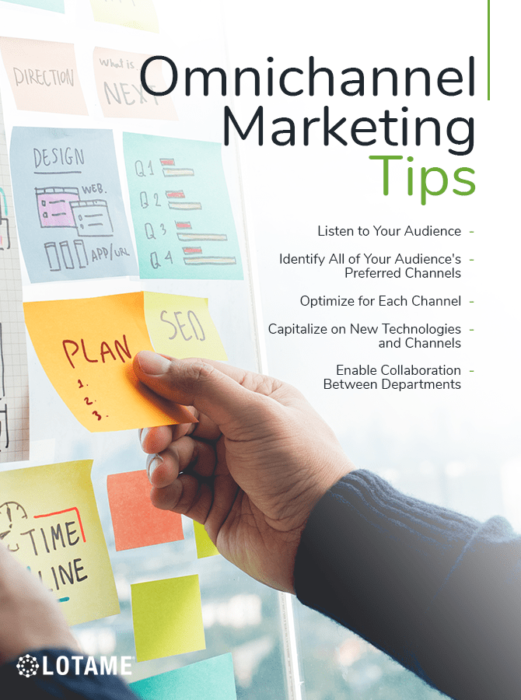
See How Lotame Can Help Your Omnichannel Marketing
Ready to get started with omnichannel marketing or add to your omnichannel strategy? Check out the following tips.
1. Listen to Your Audience
To create an effective omnichannel marketing strategy, you need to take the time to get to know your audience and learn about their wants, needs, interests and preferences. One way to get to know your audience is to ask them about themselves directly via surveys distributed through email, phone and other methods. You can also visit the profiles of your social media followers to see what their interests are.
Also, with Lotame’s data connectivity solutions, you can collect event-level data whenever customers interact with you online and upload offline data from your CRM and other sources. Our technology helps you organize all of your customer data, and uncover useful insights about what your audience wants.
2. Identify All of Your Audience’s Preferred Channels
You also need to identify as many of the channels your audience is using as possible so you can reach them on those channels. If you don’t use some of these channels, you’ll miss out on marketing opportunities and may have gaps in your messaging. If you don’t advertise on a particular social media site, for instance, and a competitor does, you may end up losing out on a sale.
To determine which channels to use, use monitoring tools to track keywords people interested in your products or services might use. The keywords might be the name of your products or services, something about the problem they solve, your business name and the names of your competitors. Many of the sites on which these keywords show up, which may include blogs, forums and social media sites, will be sites your audience uses when researching the kinds of products you provide. You can also compare the demographics of users of certain sites to the demographics of your current audience.
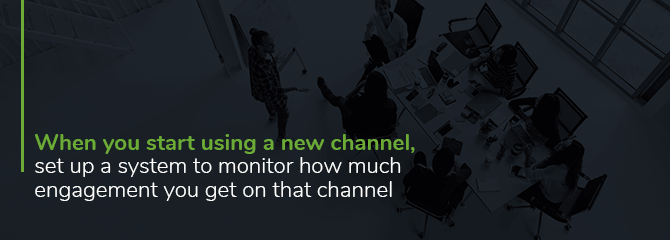
When you start using a new channel, set up a system to monitor how much engagement you get on that channel. This will help you ensure you’re investing your time in the right areas.
3. Optimize for Each Channel
Not every type of content works well on every channel, so make sure you optimize your content for each one. Use responsive design so your website looks good on every computer, tablet and smartphone. Also, post the right type of content for each social media channel you use. On Facebook, videos get more engagement than other kinds of posts, while photos do well on Instagram. Pinterest favors infographics, and Twitter is best for news, blogs and GIFs.
4. Capitalize on New Technologies and Channels

Technology changes quickly, and omnichannel marketers need to keep up if they want to take advantage of new opportunities, stay ahead of the competition and reach their audience.
Marketing automation can save you a significant amount of time, allowing you to reach more customers with the same amount of resources. In-store technology, such as Crate and Barrel’s Mobile Totes tablets, can help you to connect your brick-and-mortar stores to your digital marketing campaigns. Augmented and virtual reality also offers new ways to interact with customers. Beauty retailer Sephora, for instance, uses augmented reality and facial recognition technology to let customers try on products on its app and website.
Marketers also need to keep an eye out for new channels and technologies. New social media sites could potentially be a goldmine for a company that finds it early, and some new social media features provide opportunities to sell directly to customers. Facebook launched its Marketplace feature in October 2016, and today, 800 million people in 70 countries use it each month.
5. Enable Collaboration Between Departments
An omnichannel marketing approach requires that customers have a consistent experience across all channels, which means that every department involved needs to be on the same page. Everyone needs to understand the kind of messaging and experience customers should have.
Departments will also need to share information quickly and easily. For example, if the customer service team gets a call from an unhappy customer who wants to return a product, marketing should be aware of that so they can adjust their messaging to that person accordingly. They might, for instance, offer them a discount to try the product again. If they weren’t aware of the issue, on the other hand, they might instead try to upsell the customer, which would likely annoy them.
Why Is Omnichannel Marketing Important?
People today expect personalized experiences, whether it’s movie recommendations from streaming services based on their tastes or product recommendations based on their past purchases. That’s why personalized advertising is so important.
Customers will quickly get annoyed with advertisements that are repetitive or aren’t relevant to them. Without an omnichannel system in place, you might send an ad for a product a customer already purchased because the advertising team wasn’t informed of the purchase. If you repeatedly send this ad to the customer, they may get irritated and be less likely to shop with you in the future. Of course, targeting ads to people to whom they aren’t relevant also translates to wasted ad dollars.

Today, 73 percent of people shop on multiple channels. Because shoppers move seamlessly between channels, marketers need to do the same. If you only focus on one channel, you’ll miss out on an advertising opportunity when shoppers hop to another channel. If you don’t integrate your various channels, your messaging will be disjointed. You could be moving the customer through the marketing funnel across numerous channels, but without integration, you’ll have to start at the beginning of the funnel on each channel.
Omnichannel marketing also helps you to be consistent across channels, which is something customers have come to expect. Many shoppers, especially millennials, want a consistent experience from brands across online, in-store and phone channels. These channels can include search, leveraging Google Ads to stay in front of customers, personalized email marketing that uses the data you have to send the right email at the right time with the right offer, SMS, social, in-store offers and more.
Ultimately, omnichannel marketing is linked to more marketing success. According to a report from Omnisend, marketers that use an omnichannel strategy see 250 percent higher purchase frequency than those using a single-channel approach. Omnichannel marketeers also see 90 percent higher customer retention rates.
How Lotame Can Help You Find Omnichannel Success

To create an effective omnichannel marketing strategy, you need to be able to collect, organize, analyze and activate your data successfully. Lotame’s data connectivity solutions can help you to do all of these things so you can meet the goals of your omnichannel marketing campaigns. To learn more about how Lotame can help create and optimize your omnichannel marketing strategies, contact us today.

